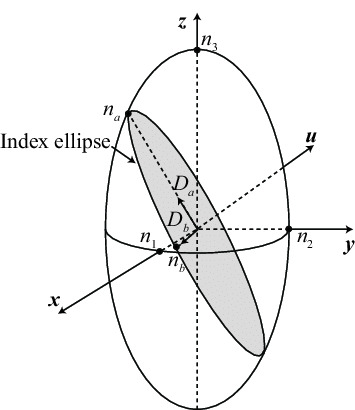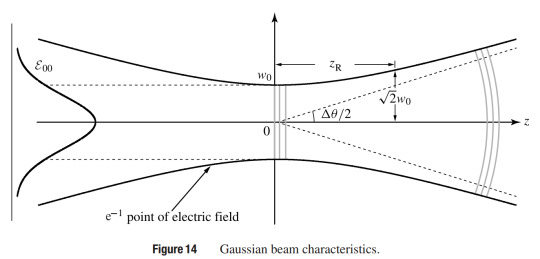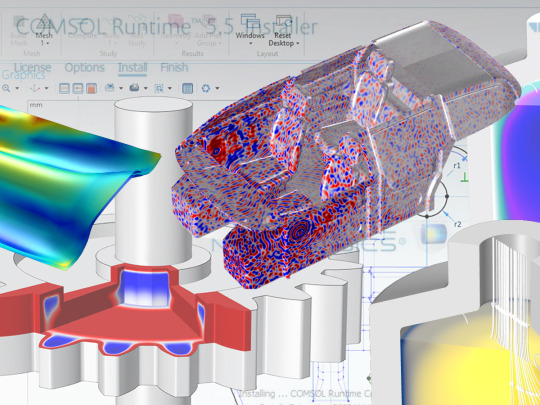#MULTIPHYSICS
Explore tagged Tumblr posts
Photo

Vibration and noise analysis in a 5-speed synchromesh gearbox inside a manual transmission vehicle
#vehicle design#car design#acoustics#simulation#physics#science#engineering#graphics#COMSOL#modeling#multiphysics
61 notes
·
View notes
Text

noosphe
Ahmed Salman
#VEHICLE DESIGN#CAR DESIGN#ACOUSTICS#SIMULATION#PHYSICS#SCIENCE#ENGINEERING#GRAPHICS#COMSOL#MODELING#MULTIPHYSICS#Ahmed Salman#nooshpe.re#nooshpe
3 notes
·
View notes
Text
What have I been up to? Well more or less more optics.
I started to learn about the Index Ellipsoid, and I am beginning to understand how we can quantify a materials allowed polarizations using the "indicatrix" (not going to lie this is a hard word to spell lol)
I now understand that there are two possible electric flux densities (basically the quadratic equations +/- gives two roots, so when you solve for two possible refractive indices, you also get two D solutions) and that these two fluxes are orthogonal.
The index Ellipsoid let's us characterize anisotropic crystals into biaxial (two defined optical axes) and uniaxial (two axes are equal)

But honestly, I'm hitting a bit of a wall here. I just want to be familiar with the material before grad school starts. Since I'm self studying now, I decided to venture off into a related topic: Computational electromagnetics!!
I took numerical methods this winter so when I heard about Finite Difference Method I didn't look like a 🦌 staring at 🚗 lol (honestly I find Runge-Kutta methods scarier haha)
So I learned a bit about collocated grids, recalled Dirichlet boundary conditions, periodic boundary conditions as well as Neuman boundary conditions.
My plan is to use COMSOL multi physics to do a little simulation for my masters thesis, so I'm betting that having a grasp on the numerical side of emag is something I need to accomplish to bear fruitful results.
And of course I get hit with the realization exactly *why* plane waves are used to teach us optics: because they are simply a stepping stone towards us learning about Gaussian Beams!

The 🐇 hole just keeps getting deeper and deeper... 🕳️
#anisotropy#optics#physics#math#electromagnetics#gaussian beam#boundary conditions#Neumann#Dirichlet#COMSOL multiphysics#numerical electromagnetics#Finite Difference Methods#SoundCloud
0 notes
Text
Come attivare il ribbon in LibreOffice
Come attivare il ribbon in LibreOffice
Uso pochissimo Office di Microsoft e quasi sempre per motivi lavorativi ma devo ammettere che, a parte certe funzioni di Excel, se c’è una cosa che mi piace di Office è la sua interfaccia a ribbon, nella quale tutti i comandi (o quasi) sono raggruppati in modo omogeneo in schede ben distinte. Il ribbon, in pratica, sostituisce i menu e rende i comandi più facilmente accessibili, dato che ciascuna…

View On WordPress
#apple#comsol multiphysics#interfaccia grafica#keynote#libreoffice#matlab#microsoft office#numbers#pages#ribbon#sibelius
0 notes
Text
Computational Fluid Dynamics (CFD) has become an essential tool for engineers and researchers who need to simulate and analyze fluid flow, heat transfer, and other related physical processes. Accurate CFD simulations can save time, reduce costs, and improve product design across industries such as aerospace, automotive, energy, and manufacturing. In this blog, we’ll explore some of the top CFD simulation software options available today that can significantly enhance the accuracy and efficiency of your simulations.
1. ANSYS Fluent
One of the most widely used CFD software solutions, ANSYS Fluent is known for its versatility and comprehensive range of simulation capabilities. It allows users to simulate complex fluid flow, turbulence, heat transfer, and chemical reactions. Fluent is popular because of its ability to handle both steady and transient flow scenarios, as well as its advanced meshing tools that improve the accuracy of simulations. Additionally, the software is highly customizable, with a user-friendly interface and detailed post-processing features that help you gain deeper insights from your results.
Key Features:
Wide range of physical models for complex flows
Advanced turbulence models
High-performance computing (HPC) support
Easy integration with other ANSYS tools
2. Siemens STAR-CCM+
STAR-CCM+, part of Siemens’ Simcenter suite, is another leading CFD simulation software known for its flexibility and integration with other simulation tools. It provides a multidisciplinary approach, allowing users to perform CFD simulations alongside structural and thermal analysis. One of STAR-CCM+'s biggest strengths is its ability to solve complex real-world engineering problems with high accuracy. The software also supports automated workflows, making it an excellent choice for users who require quick turnaround times for multiple simulations.
Key Features:
Multidisciplinary simulation environment
Automated meshing and simulation setup
Ability to handle large, complex models
Efficient solvers for faster simulations
3. OpenFOAM
OpenFOAM is an open-source CFD software that has gained significant popularity due to its flexibility, customizability, and cost-effectiveness. Unlike proprietary software, OpenFOAM allows users to tailor the code to their specific simulation needs. It is particularly favored by academic researchers and institutions for its ability to handle custom and unconventional simulations. While it may not be as user-friendly as other commercial software, OpenFOAM's vast array of solvers and utilities makes it a powerful tool for those who require more control over their simulations.
Key Features:
Open-source and free to use
Highly customizable with user-written code
A wide range of solvers for various CFD applications
Strong community support and active development
4. COMSOL Multiphysics
While COMSOL Multiphysics is primarily known for its multiphysics capabilities, it also offers robust CFD simulation tools. It is especially useful when you need to simulate fluid dynamics alongside other physical phenomena, such as structural mechanics or electromagnetics. COMSOL’s intuitive user interface makes it easier for users to set up complex simulations, and its built-in post-processing tools provide detailed visualization options for analyzing results.
Key Features:
Seamless coupling of CFD with other physics simulations
Easy-to-use interface for faster setup
Excellent post-processing and visualization tools
Supports various fluid dynamics applications
5. Altair AcuSolve
AcuSolve by Altair is a powerful CFD solver that excels in solving fluid dynamics problems quickly and accurately. Its advantage lies in its unique solution algorithms that ensure fast convergence, making it ideal for simulations where time is a critical factor. AcuSolve also integrates well with other Altair products, offering a streamlined experience for users working on multidisciplinary projects.
Key Features:
Fast and robust solvers
Accurate simulations with minimal meshing effort
Excellent integration with other Altair tools
Ideal for transient and steady-state simulations
Conclusion
Choosing the right CFD simulation software depends on your specific needs, such as the complexity of your simulations, the required accuracy, and your budget. Whether you're looking for a user-friendly platform like ANSYS Fluent or a cost-effective solution like OpenFOAM, each software package offers distinct advantages that can help you optimize your fluid dynamics simulations. By leveraging the right tools, you can improve the accuracy and efficiency of your simulations, leading to better insights and more informed engineering decisions.
Visit us to Know More Website:https://www.cfdsupport.com/ Location:CFD support, s.r.o., Sokolovská 270/201, 19000 Praha 9, Czech Republic. Contact Us:+420 212 243 883 Email:[email protected]
0 notes
Text
Computer Aided Engineering Market 2024 : Size, Growth Rate, Business Module, Product Scope, Regional Analysis And Expansions 2033
The computer aided engineering global market report 2024 from The Business Research Company provides comprehensive market statistics, including global market size, regional shares, competitor market share, detailed segments, trends, and opportunities. This report offers an in-depth analysis of current and future industry scenarios, delivering a complete perspective for thriving in the industrial automation software market.
Computer Aided Engineering Market, 2024 report by The Business Research Company offers comprehensive insights into the current state of the market and highlights future growth opportunities.

Market Size - The computer aided engineering market size has grown strongly in recent years. It will grow from $8.97 billion in 2023 to $9.87 billion in 2024 at a compound annual growth rate (CAGR) of 10.0%.The growth in the historic period can be attributed to advancements in computational power, globalization of engineering work, increasing complexity in product design, simulation-driven design, cost and time savings, regulatory compliance requirements, automotive crash testing simulation.
The computer aided engineering market size is expected to see strong growth in the next few years. It will grow to $14.1 billion in 2028 at a compound annual growth rate (CAGR) of 9.3%.The growth in the forecast period can be attributed to rise of industry 4.0 and smart manufacturing, increased complexity in electronics design, focus on sustainability and environmental impact, enhanced human-machine interaction simulations, digitalization of construction and infrastructure, increased use in consumer electronics. Major trends in the forecast period include increased integration of multiphysics simulations, advancements in high-performance computing (hpc), growing adoption of cloud-based cae, focus on user-friendly interfaces and workflows, increased use of generative design, use of virtual prototyping for system-level simulation.
Order your report now for swift delivery @ https://www.thebusinessresearchcompany.com/report/computer-aided-engineering-global-market-report
The Business Research Company's reports encompass a wide range of information, including:
1. Market Size (Historic and Forecast): Analysis of the market's historical performance and projections for future growth.
2. Drivers: Examination of the key factors propelling market growth.
3. Trends: Identification of emerging trends and patterns shaping the market landscape.
4. Key Segments: Breakdown of the market into its primary segments and their respective performance.
5. Focus Regions and Geographies: Insight into the most critical regions and geographical areas influencing the market.
6. Macro Economic Factors: Assessment of broader economic elements impacting the market.
Market Drivers - Increasing automation in the manufacturing sector is expected to propel the growth of the computer-aided engineering market going forward. Automation refers to the development and deployment of technologies for the production and delivery of products and services with little or no human participation. Automation technologies such as computer-aided drafting and computer-assisted N/C tape preparation are now available and widely used in the manufacturing sector to help reverse the troubling trend of declining productivity. For instance, in September 2023, according to the International Federation of Robotics (IFR), a Germany-based professional non-profit organization, the total number of service robots sold for professional use hit 158,000 units in 2022—an increase of 48%. It is recorded that 553,052 industrial robot installations are in factories around the world—a growth rate of 5% in 2022, year-on-year. Therefore, increasing automation in the manufacturing sector is expected to drive the growth of the computer-aided engineering market.
Market Trends - Technological advancements are the key trend gaining popularity in the computer-aided engineering market. Major companies operating in computer-aided engineering are focused on developing new technological solutions to attain a competitive edge in the market. For instance, in June 2021, Siemens AG, a German-based industrial manufacturing company, launched Simcenter Femap, a sophisticated simulation application that allows users to create, update, and evaluate finite element models of complicated goods or systems. Simcenter Femap offers sophisticated data-driven and graphical result visualization and assessment when paired with the industry-leading Simcenter Nastran, resulting in a full computer-aided engineering solution that optimizes the product's performance. When paired with the industry-leading Simcenter Nastran, Simcenter Femap offers sophisticated data-driven and graphical results display and evaluation, resulting in a full CAE solution that enhances product performance.
The computer aided engineering market covered in this report is segmented –
1) By Type: Finite Element Analysis (FEA), Computational Fluid Dynamics (CFD), Multibody Dynamics, Optimization and Simulation 2) By Depolyment: On-Premise, Cloud-Based 3) By End-Use: Automotive, Defense and Aerospace, Electronics, Medical Devices, Industrial Equipment
Get an inside scoop of the computer aided engineering market, Request now for Sample Report @ https://www.thebusinessresearchcompany.com/sample.aspx?id=7941&type=smp
Regional Insights - Europe was the largest region in the computer-aided engineering market in 2023. The regions covered in the computer aided engineering market report are Asia-Pacific, Western Europe, Eastern Europe, North America, South America, Middle East, Africa.
Key Companies - Major companies operating in the computer aided engineering market report are Altair Engineering Inc., Dassault Systèmes SE, ESI Group, Siemens AG, Hexagon AB, Seiko Epson Corporation, Exa Corporation, Bentley Systems Inc., Numeca International, Dell Inc., Aspen Technology Inc., Symscape Pty Ltd, Synopsys Inc., Aveva Group plc, Autodesk Inc., ANSYS Inc., PTC Inc., COMSOL Inc., MSC Software Corporation, Mentor Graphics Corporation, The MathWorks Inc., OpenText Corporation, Siemens Industry Software NV, CD-adapco, ETA Engineering Inc., Ricardo Software, ZWSOFT Co. Ltd., Zemax LLC, Flow Science Inc., GNS Systems GmbH, AVL List GmbH, EnginSoft S.p.A.
Table of Contents 1. Executive Summary 2. Computer Aided Engineering Market Report Structure 3. Computer Aided Engineering Market Trends And Strategies 4. Computer Aided Engineering Market – Macro Economic Scenario 5. Computer Aided Engineering Market Size And Growth ….. 27. Computer Aided Engineering Market Competitor Landscape And Company Profiles 28. Key Mergers And Acquisitions 29. Future Outlook and Potential Analysis 30. Appendix
Contact Us:
The Business Research Company
Europe: +44 207 1930 708
Asia: +91 88972 63534
Americas: +1 315 623 0293
Email: [email protected]
Follow Us On:
LinkedIn: https://in.linkedin.com/company/the-business-research-company
Twitter: https://twitter.com/tbrc_info
Facebook: https://www.facebook.com/TheBusinessResearchCompany
YouTube: https://www.youtube.com/channel/UC24_fI0rV8cR5DxlCpgmyFQ
Blog: https://blog.tbrc.info/
Healthcare Blog: https://healthcareresearchreports.com/
Global Market Model: https://www.thebusinessresearchcompany.com/global-market-model
0 notes
Text
https://electronicsbuzz.in/faraday-enhances-3d-ic-design-service-with-ansys-multiphysics-analysis/

0 notes
Photo

COMSOL Multiphysics https://audioxpress.com/news/version-5-5-of-comsol-multiphysics-is-now-available
33 notes
·
View notes
Text
Data-Constrained Modelling of Material Microstructures and Properties_Crimson Publishers

Data-Constrained Modelling of Material Microstructures and Properties by YS Yang* in Crimson Publishers: Peer Reviewed Material Science Journals
This article is a review of our recent development in data-constrained modelling (DCM) methodology for quantitative and sample-non-destructive (SND) characterization of 3D microscopic composition distribution in materials, and microstructure-based predictive modelling of material multiphysics properties. Potential impacts are illustrated with examples in a range of R&D disciplines.
For more Open access journals in Crimson Publishers please click on below link https://crimsonpublishersresearch.com/
For more article in Peer Reviewed Material Science Journals please click on below link https://crimsonpublishers.com/rdms/
#crimson publishers#crimson publishers llc#crimsonpublishers#crimson publishers google scholar#journal of materials science & technology
0 notes
Text
Internal Combustion Engine Simulation Software | Multiphysics Engineering Solutions - ESPL
At ESPL, we are supporting our customers in the Internal Combustion Engine (ICE) Powertrain system simulations practically from the day one Over the years, we have developed very good expertise in multi physics engineering solutions while simulating almost all Physics associated with ICE Powertrain. To know more about this visit https://eqmsol.com/ICE-powertrain.php
0 notes
Text
Siemens Star CCM+ 2406R8 v19 Lifetime License
Siemens Star CCM+ 2406R8 v19 Lifetime License. Siemens Star CCM+ 2406R8 v19 is a comprehensive software solution for Computational Fluid Dynamics (CFD), Multiphysics, and design exploration. This powerful tool allows engineers and designers to simulate and analyze complex fluid flows and physical phenomena to optimize product performance. With a Lifetime License, users gain perpetual access to…
0 notes
Text
Top IT Companies that Hire Mechanical Engineers in India
IT companies value several specific skills from mechanical engineering, which are essential for various roles and projects within the IT sector. These skills include:
Technical Skills
1. Computer-Aided Design (CAD) and Solid Modeling:
• CAD software: Tools like SolidWorks, AutoCAD, and CATIA are used to create 2D and 3D models of mechanical objects, which are crucial for designing, analyzing, and simulating products.
• Solid modeling: This involves creating detailed components and models of mechanical parts, which is vital for designing specialty machines and validating form, fit, and function.
2. Finite Element Analysis (FEA):
• FEA software: Tools like ANSYS, Abaqus, and COMSOL Multiphysics are used to analyze the structural and thermal behavior of mechanical objects, simulating stresses, strains, and deformations under different loading conditions.
3. Programming Skills:
• Programming languages: Mechanical engineers often need to automate tasks, control machines, and develop simulations using programming languages like Python, MATLAB, and C++.
4. Mathematics:
• Calculus, differential equations, and linear algebra: These skills are essential for understanding the behavior of mechanical systems and designing safe and efficient products.
5. Problem-Solving Skills:
• Creative problem-solving: Mechanical engineers need to identify and solve complex problems, often requiring innovative solutions.
6. System Analysis and Integration:
• Systems engineering: This involves designing, analyzing, and integrating complex systems, which is valuable in IT for designing and managing software systems.
7. Materials Science and Engineering:
• Materials expertise: Understanding the properties and behavior of materials is crucial for designing and optimizing mechanical systems and products.
8. 3D Printing and Additive Manufacturing:
• 3D printing: This technology is increasingly used in IT for rapid prototyping and manufacturing, making mechanical engineers with this skillset highly valuable.
Soft Skills
1. Communication:
• Effective communication: Mechanical engineers need to convey technical concepts clearly to various stakeholders, including engineers, technicians, and customers.
2. Teamwork:
• Collaboration: Mechanical engineers often work in teams, requiring strong collaboration and teamwork skills to share ideas, listen to feedback, and compromise.
3. Critical Thinking and Logical Thinking:
• Analytical thinking: Mechanical engineers must approach problems systematically, understand the end goal, note constraints, and use knowledge to find solutions.
4. Project Management:
• Project management: Mechanical engineers are often involved in managing projects, including budgeting, scheduling, and coordinating tasks with stakeholders.
5. Adaptability and Flexibility:
• Adaptability: Mechanical engineers need to be flexible and adapt to new technologies and methodologies, which is crucial in the rapidly evolving IT sector.
6. Data Analysis and Optimization:
• Data analysis: Mechanical engineers need to analyze data to optimize systems and processes, which is increasingly important in IT for data-driven decision-making.
These skills are highly valued by IT companies because they enable mechanical engineers to contribute effectively to various aspects of software development, system architecture, and project management, ultimately enhancing the efficiency and innovation of IT projects.
An IT company might hire a mechanical engineer for their expertise in problem-solving, analytical skills, and understanding of mechanical systems, which are valuable for various IT projects, such as hardware development, robotics, and systems integration. Graduates from Top Engineering Colleges, including Arya College of Engineering and IT, bring a solid foundation in engineering principles and innovative thinking, making them an asset in multidisciplinary IT teams. This blend of mechanical and IT knowledge can drive technological advancements and improve overall project outcomes.
0 notes
Text
カナダのBanff International Research Stationに来ています。Mathematics of Multiscale and Multiphysics Phenomena in Materials Science (24w5159)に参加します
0 notes
Text
Top CFD Simulation Software: Tools to Boost Accuracy and Efficiency in Fluid Dynamics
Computational Fluid Dynamics (CFD) has become an essential tool for engineers and researchers who need to simulate and analyze fluid flow, heat transfer, and other related physical processes. Accurate CFD simulations can save time, reduce costs, and improve product design across industries such as aerospace, automotive, energy, and manufacturing. In this blog, we’ll explore some of the top CFD simulation software options available today that can significantly enhance the accuracy and efficiency of your simulations.

1. ANSYS Fluent
One of the most widely used CFD software solutions, ANSYS Fluent is known for its versatility and comprehensive range of simulation capabilities. It allows users to simulate complex fluid flow, turbulence, heat transfer, and chemical reactions. Fluent is popular because of its ability to handle both steady and transient flow scenarios, as well as its advanced meshing tools that improve the accuracy of simulations. Additionally, the software is highly customizable, with a user-friendly interface and detailed post-processing features that help you gain deeper insights from your results.
Key Features:
Wide range of physical models for complex flows
Advanced turbulence models
High-performance computing (HPC) support
Easy integration with other ANSYS tools
2. Siemens STAR-CCM+
STAR-CCM+, part of Siemens’ Simcenter suite, is another leading CFD simulation software known for its flexibility and integration with other simulation tools. It provides a multidisciplinary approach, allowing users to perform CFD simulations alongside structural and thermal analysis. One of STAR-CCM+'s biggest strengths is its ability to solve complex real-world engineering problems with high accuracy. The software also supports automated workflows, making it an excellent choice for users who require quick turnaround times for multiple simulations.
Key Features:
Multidisciplinary simulation environment
Automated meshing and simulation setup
Ability to handle large, complex models
Efficient solvers for faster simulations
3. OpenFOAM
OpenFOAM is an open-source CFD software that has gained significant popularity due to its flexibility, customizability, and cost-effectiveness. Unlike proprietary software, OpenFOAM allows users to tailor the code to their specific simulation needs. It is particularly favored by academic researchers and institutions for its ability to handle custom and unconventional simulations. While it may not be as user-friendly as other commercial software, OpenFOAM's vast array of solvers and utilities makes it a powerful tool for those who require more control over their simulations.
Key Features:
Open-source and free to use
Highly customizable with user-written code
A wide range of solvers for various CFD applications
Strong community support and active development
4. COMSOL Multiphysics
While COMSOL Multiphysics is primarily known for its multiphysics capabilities, it also offers robust CFD simulation tools. It is especially useful when you need to simulate fluid dynamics alongside other physical phenomena, such as structural mechanics or electromagnetics. COMSOL’s intuitive user interface makes it easier for users to set up complex simulations, and its built-in post-processing tools provide detailed visualization options for analyzing results.
Key Features:
Seamless coupling of CFD with other physics simulations
Easy-to-use interface for faster setup
Excellent post-processing and visualization tools
Supports various fluid dynamics applications
5. Altair AcuSolve
AcuSolve by Altair is a powerful CFD solver that excels in solving fluid dynamics problems quickly and accurately. Its advantage lies in its unique solution algorithms that ensure fast convergence, making it ideal for simulations where time is a critical factor. AcuSolve also integrates well with other Altair products, offering a streamlined experience for users working on multidisciplinary projects.
Key Features:
Fast and robust solvers
Accurate simulations with minimal meshing effort
Excellent integration with other Altair tools
Ideal for transient and steady-state simulations
Conclusion
Choosing the right CFD simulation software depends on your specific needs, such as the complexity of your simulations, the required accuracy, and your budget. Whether you're looking for a user-friendly platform like ANSYS Fluent or a cost-effective solution like OpenFOAM, each software package offers distinct advantages that can help you optimize your fluid dynamics simulations. By leveraging the right tools, you can improve the accuracy and efficiency of your simulations, leading to better insights and more informed engineering decisions.
Visit us to Know More Website:https://www.cfdsupport.com/ Location:CFD support, s.r.o., Sokolovská 270/201, 19000 Praha 9, Czech Republic. Contact Us:+420 212 243 883 Email:[email protected]
1 note
·
View note